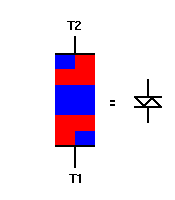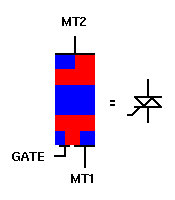|
|
www.play-hookey.com | Mon, 08-26-2002 |
| Digital | Logic Families | Digital Experiments | Analog | Optics | Computers | Semiconductors | Test HTML | ||
| Direct Links to Other Semiconductors Pages: | |
|---|---|
| Basic Semiconductor Structures: | [Basic Semiconductor Crystal Structure] [The PN Junction] [The Transistor] |
| Field Effect Transistors (FETs): | [Junction FET] [Depletion Mode MOSFET] [Enhancement Mode MOSFET] |
| Adding More Junctions: | [The Four-Layer Diode] [The Silicon Controlled Rectifier] [The Silicon Controlled Switch] [The Diac and Triac] |
| Specialized Devices: | [A Touch of Physics] [Specialized Diodes] [The Unijunction Transistor] |
| The Diac and Triac |
|---|
One of the drawbacks of all of the four-layer diodes is that they all require a dc voltage of the correct polarity in order to operate. It would be nice if we could have some sort of SCR that works for either polarity, so it can be used with an applied ac voltage.
Now, we created the four-layer devices by essentially connecting two transistors back to back in a single silicon crystal. Can we extend this concept and connect two SCRs back to back?

The diagram to the right shows the resulting five-layer device, which is known as a diac. At first glance, it seems unreasonable or even impossible, considering that each connection to the semiconductor crystal overlaps a pn junction. However, the device does work, and indeed works well.
The terms anode and cathode no longer apply, so the connections are simply named terminal 1 (T1) and terminal 2 (T2). Each terminal can serve as either anode or cathode, according to the polarity of the applied voltage.
That same applied polarity also determines which of the end junction is active, and which one is bypassed. Thus, if T1 is positive with respect to T2, T1's N-type region is ignored (electrons are pulled away from that junction) and its P-type region serves as the anode. At the same time, the relative negative voltage at T2 pulls holes from the P-type region towards the terminal (removing them from the next junction), but tends to push electrons from its N-type region across that junction into the P-type region, thus making them available for conduction.
The diac, like the four-layer diode, remains non-conducting until its breakover voltage is reached, at which point it turns on fully and remains on until the applied voltage or circuit current are reduced below the holding values at which conduction can be maintained. Since the diac is normally used in ac circuits, operating as part of the control circuit for devices powered from a household wall socket or similar source, this is not a problem. In such applications, the diac is triggered each half-cycle of ac power, and then turns off at the end of the half-cycle when the line voltage reverses polarity.

The drawback of the diac is the same as it was for the four-layer diode: it cannot be triggered at just any point in the ac power cycle; it triggers at its preset breakover voltage only. If we could add a gate to the diac, we could have variable control of the trigger point, and therefore a greater degree of control over just how much power will be applied to the line-powered device.
The figure to the right shows the result. This device is known as a triac. Here, the main connections are simply named main terminal 1 (MT1) and main terminal 2 (MT2). The gate designation still applies, and is still used as it was with the SCR.
The useful feature of the triac is that it not only carries current in either direction, but the gate trigger pulse can be either polarity regardless of the polarity of the main applied voltage. The gate can inject either free electrons or holes into the body of the triac to trigger conduction either way. For this reason, you may see the triac referred to as a "four-quadrant" device.
As with the diac, the triac is used in an ac environment, so it will always turn off when the applied voltage reaches zero at the end of the current half-cycle. If we apply a turn-on pulse at some controllable point after the start of each half cycle, we can directly control what percentage of that half-cycle gets applied to the load, which is typically connected in series with MT2. This makes the triac an ideal candidate for light dimmer controls and motor speed controls. This is a common application for triacs.
|
|
|
|
|
All pages on www.play-hookey.com copyright © 1996, 2000-2002 by
Ken Bigelow Please address queries and suggestions to: webmaster@play-hookey.com |